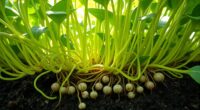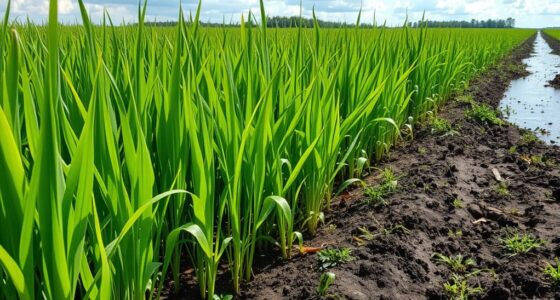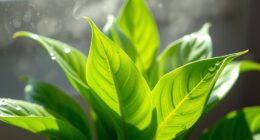You might be surprised to learn that epiphytes and air plants thrive without soil by using specialized adaptations like aerial roots and water-absorbing leaves. They grow on trees, adding diversity and supporting ecosystems by providing habitat, food, and shelter for various species. Their unique nutrient strategies help them survive in nutrient-poor environments. If you keep exploring, you’ll discover how these fascinating plants impact biodiversity and ecosystem health in remarkable ways.
Key Takeaways
- Epiphytes and air plants grow without soil, attaching to trees and other structures to access light and air.
- They absorb nutrients and moisture directly from the air, rain, and debris through specialized adaptations.
- These plants contribute to biodiversity by providing habitat, food, and shelter for various animals.
- Their presence indicates healthy ecosystems, especially in tropical forests, and they help regulate humidity and air quality.
- They face threats from habitat loss and environmental changes, highlighting their role in conservation and ecosystem stability.

Epiphytes and air plants are fascinating types of plants that thrive without soil, growing instead on the branches and trunks of trees. This unique lifestyle showcases their incredible plant adaptation skills, allowing them to survive in environments where soil is scarce or unavailable. By learning about these plants, you gain insight into how nature maintains biodiversity conservation, as epiphytes contribute considerably to the ecosystems they inhabit. Their presence increases habitat complexity and provides food and shelter for numerous animals, making them crucial components of forest biodiversity.
You might wonder how these plants manage to get nutrients and water without roots in the soil. Epiphytes have evolved specialized adaptations, such as aerial roots and thick, water-absorbing leaves, that enable them to capture moisture from the air, rain, or debris that accumulates around them. These adaptations ensure they can thrive in their lofty positions, where soil-based nutrients are absent. Their ability to grow without soil also minimizes competition for resources on the forest floor, allowing a diverse array of plant species to coexist. This plant strategy underscores the importance of understanding plant adaptation mechanisms, especially as many species face threats from habitat destruction and climate change.
Additionally, some epiphytes utilize unique nutrient acquisition strategies like trapping organic matter and decomposing it to obtain essential nutrients, further demonstrating their remarkable adaptability. As you observe epiphytes and air plants, you notice how they contribute to the overall health of their ecosystems. They help regulate humidity and air quality and support a variety of pollinators and seed dispersers. Their role in biodiversity conservation becomes evident when you realize that protecting epiphyte populations means safeguarding the intricate web of life they support. In many tropical forests, epiphytes like orchids, bromeliads, and mosses are key indicators of ecosystem health. Their presence signals a well-preserved habitat, while their decline often points to environmental stressors such as deforestation or pollution.
Frequently Asked Questions
How Do Epiphytes Affect Their Host Trees’ Health?
You might wonder how epiphytes impact their host tree health. They usually don’t harm the tree directly but can cause epiphyte competition for light and nutrients. Excessive growth might weigh down branches or block sunlight, stressing the tree. However, in moderation, epiphytes coexist peacefully, adding ecological diversity without significant harm. Your role is to observe and manage their growth to ensure the host tree remains healthy and balanced.
Can Air Plants Survive in Completely Dark Environments?
Imagine you’re in a dark, medieval castle—no sunlight—can air plants survive? Not really. They need light requirements to photosynthesize, so complete darkness isn’t suitable. Their adaptation strategies include thriving in dappled light or indirect sunlight, but total darkness hampers their growth. Without any light, they can’t produce energy, so they won’t survive long in such environments. You’d have better luck with plants that flourish in low-light or dark conditions.
What Are the Fastest-Growing Epiphyte Species?
You’re wondering about the fastest-growing epiphyte species. In epiphyte cultivation, several species exhibit rapid growth, especially under ideal conditions. Factors like humidity, light, and nutrition influence rapid growth. For instance, some orchids and Tillandsia (air plants) are known for quick development. By optimizing these rapid growth factors, you can encourage faster growth and healthier plants, making your epiphyte collection more vibrant and lush in less time.
How Do Epiphytes Contribute to Local Ecosystems?
Imagine epiphytes as nature’s aerial architects, weaving life through the canopy. You see, they contribute by fostering root symbiosis, helping plants absorb nutrients from the air and debris. This boosts nutrient cycling, enriching the ecosystem. As they provide habitat and food for creatures, you realize they’re essential for maintaining biodiversity. Their presence keeps the forest alive, vibrant, and resilient—proof that even without soil, life finds a way.
Are Air Plants Suitable for Indoor Air Purification?
You might wonder if air plants are good for indoor air purification. While they add beauty and freshness to your space, their ability to filter toxins is limited compared to traditional indoor plants. Air plants excel at enhancing aesthetics and humidity but don’t markedly improve indoor air quality. So, if your main goal is air purification, consider combining them with other indoor plants known for better filtering capabilities.
Conclusion
Imagine a world where plants defy gravity, thriving high above the forest floor without soil. Epiphytes and air plants prove this is possible, capturing moisture and nutrients from the air and their surroundings. They challenge your ideas of growth and survival, showing nature’s ingenuity. By understanding their unique adaptations, you see a vivid picture of life thriving in unexpected places—proof that even without soil, life finds a way to flourish in the most surprising ways.










